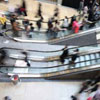
Mob Mentality
Multiple-offender crimes are less flashy than felonious
- By Ronnie Rittenberry
- Dec 01, 2011
’Tis the season to be jolly, especially
if you’re a retailer. For most stores,
the cash registers are ca-chinging
more this month than they have all year. But,
as the National Retail Federation warns, as
much as now is the time when shoppers are
walking those busy city sidewalks, it’s also
high season for the criminal-minded and thus
time to be on the lookout for those who are
out to deck the malls with bouts of larceny, fa
la la la laaaa, la la la la.
NRF is the world’s largest retail trade association,
representing an industry that includes
more than 3.6 million establishments.
Of particular concern to the organization this
holiday season is the disturbing trend of what
it calls “multiple-offender crimes” or “criminal
flash mob” activity.
These “flash robs,” as others have referred
to the misdeeds, are the darker side of the
relatively new phenomena known as flash
mobs, a concept involving groups of people
who organize via e-mail or social media and
then assemble suddenly in a public place to
perform an unusual and sometimes seemingly
pointless act. Jazz hands and a spontaneous
song in a food court or on a street corner are
usually the result, and to that extent flash
mobs are mostly innocuous, and often even
fun. Not so flash robs, which deploy the same
tactics but with a goal of wreaking havoc and
leaving retailers hurting.
Noting an uptick this year in the occurrences
of such criminal activity, NRF issued
separate, pre-holiday white papers—one
titled “Multiple-Offender Crimes: Preparing
for and Understanding the Impact of Their
Tactics,” the other “Effective Crowd Management:
Guidelines on How to Maintain the
Safety and Security of Your Customers, Employees
and Store”—both of which describe
what potential obstacles retailers are facing.
Rob ‘n’ Roll
“Multiple-offender crime incidents are
groups or gangs, often teenagers, swarming
a store and overwhelming store employees
with their sheer number and speed,” the reports
say. “Traditionally, these groups engage
in grab-and-run scenarios where offenders
quickly enter stores and target specific merchandise—
such as high-end handbags, jewelry
and designer clothing—then flee, sometimes
to a waiting vehicle or, as was the case
in several high-profile incidents, using mass
transit. Criminal flash mobs engage in serious
criminal behavior such as theft, assault,
vandalism and burglary.”
According to a separate NRF survey,
nearly one of 10 retailers says flash robbing
has already happened to them. The association
has been keeping track of occurrences of
these flash crimes, which in 2011 were widespread,
with instances reported nationwide
on average more than monthly, from Washington,
D.C., to Los Angeles.
One vivid and representative example
of flash robbing took place June 23, 2011,
at a Sears store in downtown Philadelphia.
According to police, 40 participants stormed
the store, stealing thousands of dollars in
sneakers, socks, watches and other items.
Police apprehended 15 juveniles and one
adult, all of whom were cited for retail theft
and conspiracy.
“Some would argue these are modernday
teen pranks, but in the case of multipleoffender
crime activity, they are far from it,”
NRF notes. “A gang of suspects conspiring
to commit a crime inside the store, regardless
of age, should be held fully accountable
under the law for their criminal behavior.
Given the premeditation, prosecutors
should consider felony charges for the more
serious offenders.”
Flash Pointers
If you are a store owner concerned about
the possibility of flash rob activity this holiday
season (and if you’re not, you probably
should be because, as trends go, this one’s not
waning but rather growing in direct proportion
to the rise of the social media used to
plan the events), NRF offers some guidelines
aimed at preventing such an incident.
These include having your employees report
directly to managers or loss prevention personnel
whenever they notice unusually large
gatherings of people inside or directly outside
your store. The association also recommends
monitoring social networks and websites for
indications of a planned event and sharing
such intelligence with law enforcement agencies
and whatever security firm you have.
In the event such preventive measures
don’t work and you find yourself facing a
flash rob group, NRF has advice for what to
do in the midst of one of the sudden strikes.
Among other strategies, the association
says to: attempt to discourage thefts by repositioning
workers near key areas of the
store and high-value merchandise; during the
incident, take mental note of the offenders,
including their physical description and clothing,
and, immediately following the incident,
document your observations; in worst-case
scenarios, instruct employees and customers to
retreat into a secure part of the store.
NRF notes that any video of the event
can assist in the documentation process and
should be readily available for law enforcement
officials (following company protocols
for release). The association cautions that
apprehensions should be facilitated by authorized
personnel only—and only when safe
to do so, according to applicable corporate
policy and state laws.
For a complete listing of the association’s
guidelines, and to read more about specific instances
of the flash rob activity sweeping the
nation, visit www.nrf.com. Happy holidays!
This article originally appeared in the December 2011 issue of Security Today.